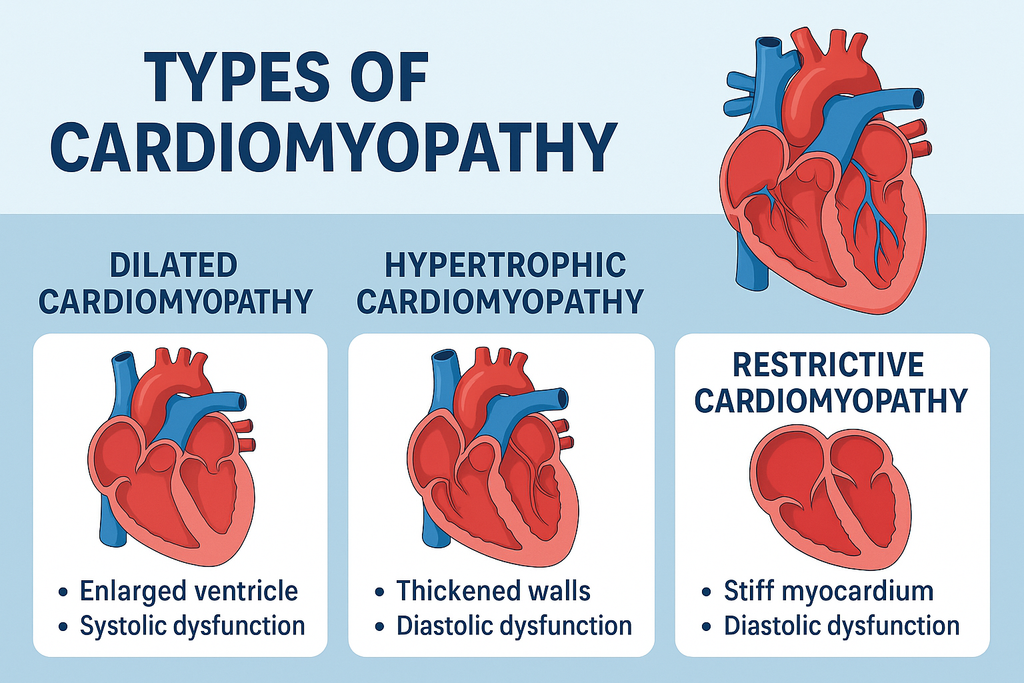News — echocardiogram
Types of Cardiomyopathy: Dilated, Hypertrophic, and Restrictive Explained
arrhythmia cardiac conditions cardiac symptoms cardiomyopathy DCM dilated cardiomyopathy echocardiogram genetic heart disease HCM heart disease heart failure heart muscle disease heart treatment hypertrophic cardiomyopathy ICD RCM restrictive cardiomyopathy sudden cardiac death types of cardiomyopathy
The heart is a powerful muscle, tirelessly working to pump life-giving blood throughout the body. But when that muscle begins to weaken or thicken in abnormal ways, cardiomyopathy may be to blame. This group of heart diseases affects the structure and function of the heart muscle, often leading to serious complications like heart failure, arrhythmias, or sudden cardiac arrest.
Understanding the different types of cardiomyopathy is crucial for both early detection and effective treatment. Each variant—dilated, hypertrophic, and restrictive—presents unique challenges and symptoms. Let’s break down the key differences between these types, explore their causes, symptoms, and management strategies, and help you recognize when to seek medical attention.
Beyond the Flu: Unmasking the Subtle Signs of Endocarditis
bacterial endocarditis blood cultures cardiac infection Duke Criteria echocardiogram endocarditis endocarditis complications endocarditis diagnosis endocarditis treatment flu-like symptoms heart heart infection heart valve infection infective endocarditis IV antibiotics for endocarditis Janeway lesions Osler nodes Roth spots signs of endocarditis silent endocarditis valve surgery
Imagine fighting off what feels like a stubborn case of the flu—fever, fatigue, aches—only to discover it’s something far more dangerous. Endocarditis, an infection of the heart’s inner lining and valves, can masquerade as a mild illness while silently damaging one of the body’s most vital organs. It’s rare, but when left undetected, it can lead to life-threatening complications like heart failure, stroke, or septicemia.
Unlike the flu, endocarditis doesn’t always wave a red flag. Its symptoms often sneak in slowly, presenting as vague and generalized—until it’s too late. That’s why knowing the subtle signs, risk factors, and pathways to diagnosis and treatment is essential, especially for those with underlying heart conditions or weakened immune systems. This guide uncovers the hidden nature of endocarditis and how you can protect your heart from this stealthy invader.
Your Heart's Early Warning System: Vascular Screening Tests Explained
AAA screening ankle-brachial index aortic aneurysm detection blood flow test cardiovascular screening carotid artery ultrasound CT angiography early detection heart echocardiogram heart check-up heart disease prevention heart health tests non-invasive heart test peripheral artery disease screening tests for heart stroke prevention vascular conditions vascular health vascular scan vascular screening
When it comes to heart health, early detection can be the difference between a manageable condition and a life-threatening emergency. The heart and blood vessels form a complex network—your vascular system—that supports every cell in your body. Unfortunately, cardiovascular diseases often develop silently, showing no symptoms until it’s too late. This is where vascular screening tests step in as your heart’s early warning system.
Vascular screening tests are designed to detect abnormalities in blood vessels that may signal the early stages of heart disease, stroke, or aneurysms. These non-invasive tests can uncover conditions long before symptoms arise, giving you a crucial head start in managing your cardiovascular health. In this guide, we’ll explore the various types of vascular screenings, what they detect, who should consider them, and how they fit into a proactive health strategy.



